What is Geofencing Marketing: A Simple Guide
Geofencing marketing is a location-based marketing strategy that allows business owners to create virtual boundaries, called a geofence, around a physical location. When someone with a mobile device enters or exits this area, it triggers marketing actions, such as sending targeted ads, push notifications, or special offers to that person’s device.
In this guide, we’ll get expert insights from our PPC Director, Gerardo Ospina, on how you can implement geofencing marketing to grow your business.
What Are The Benefits of Geofencing?
With the numerous digital marketing methods available to you, why should you consider integrating geofencing into your digital marketing campaigns? Here’s why:
Boost local visibility
Geofencing campaigns can target potential customers who are physically near your store or office location, driving foot traffic to your business and boosting your visibility in that location.
Better data for analytics
Geofencing gives you real-time insights into customer behavior in specific areas, like how often they visit, how long they stay, and how they respond to your promotions. This data helps you understand user behavior and tweak your geofencing efforts moving forward.
Personalized customer service
You can deliver personalized messages, offers, and experiences based on your customers’ preferences and behavior as they enter or leave a specific area. This personal approach boosts customer engagement and shows your customers you value them by reaching out at the right time.
Save marketing costs
Focusing your ads on a specific, high-potential audience instead of trying to reach everyone cuts down on wasted spending and allows you to get the most out of your marketing budget by reaching people who are more likely to take action.
How Does Geofencing Work?
To enable geofencing, you need to define a perimeter on a digital map, whether it’s around your business location, a neighborhood, or an entire city. When someone with location services enabled on their phone or mobile device enters or leaves that area, the system detects the movement using location data.
As soon as the mobile device crosses your geofence, an automatic action is triggered. Some examples of triggers include sending a notification or showing an ad.
Geofencing can run actively (when an app is open) or passively (in the background with little user interaction). With this setup, you can send highly targeted promotions to your audience right as they navigate around your geofence.
Types of Geofences
Radial (Circular) Geofences. You set up these geofences by choosing a central point, like your store, and defining a radius around it. This is the simplest and most common type.
Proximity Geofences. You use these for very short-range targeting, often powered by Bluetooth or Wi-Fi. For example, you can send personalized offers when someone enters a specific section of your store as a customer is approaching it.
Dynamic Geofences. This approach makes geofences adjust in real time based on factors like customer activity, traffic flow, or store hours. You can use dynamic geofences to shift your marketing based on what’s happening at a specific moment, making your messages more timely and relevant to those within a particular location.
What Businesses Is Geofencing Marketing Great For?
Geofencing works for brick-and-mortar businesses looking to attract more clients and customers and build loyalty with them over time.

Geofencing is great for any business that is aware of a particular area—whether that’s a ZIP code, city, county, or a certain mile radius around a hotspot—where there’s a concentrated amount of people looking for their service.

For example, personal injury lawyers need people who have sought medical treatment after being unjustly injured, so a logical place to geofence may be a 1 to 5 mile radius around the most populated ER clinics in that area.
Adding geofencing to your marketing methods gives you a competitive advantage, making you more visible to your target audience than your competitors.
Is Geofencing Different or Part of SEO?
Geofencing, though not inherently a component of traditional SEO, stands as a sophisticated, location-based marketing technique that can be seamlessly combined with local SEO efforts to reach business goals faster and more effectively.
Here are some differences between Geofencing and SEO:
| Category | SEO | Geofencing Marketing |
|---|---|---|
| Target Audience and Scope | Broad audience searching online, often regional or global in scope | Highly specific, location-based audience within a defined geographic area |
| Proactive vs. Reactive | Proactive: Users search, and you appear in SERPs | Reactive: Users enter a location and receive a triggered message |
| Ranking Factors | Depends on keywords, backlinks, site speed, content relevance, etc. | Depends on user location, timing, device signals, and behavioral triggers |
| Tools Used | Google Analytics, Google Search Console, SEMrush, Ahrefs | Geofencing platforms, GPS, Wi-Fi, Bluetooth, mobile ad networks |
| Content Creation Strategy | Long-form, keyword-optimized content to attract organic traffic | Short, timely, location-specific messages or offers for immediate action |
Real-Life Examples of Successful Geofencing Campaigns
You might be wondering how a small business like yours can use geofencing to bring in more customers.
Major corporations have achieved significant sales from geofencing marketing. In 2018, fast food chain Burger King used geofencing in its Whopper Detour campaign, offering 1-cent Whoppers to people within 600 feet of a McDonald’s store. It was one of Burger King’s most successful campaigns, with up to 1.5 million app downloads and $6 billion in sales throughout the campaign.

Here at On The Map Marketing, we use geofencing to boost marketing campaigns for clients in the legal, medical, and construction industries.
One example is for Indiana-based personal injury law firm Wagner Reese. In targeting birth injury cases, we set up a one to six-mile radius around hospitals and emergency rooms where birth injuries might occur.
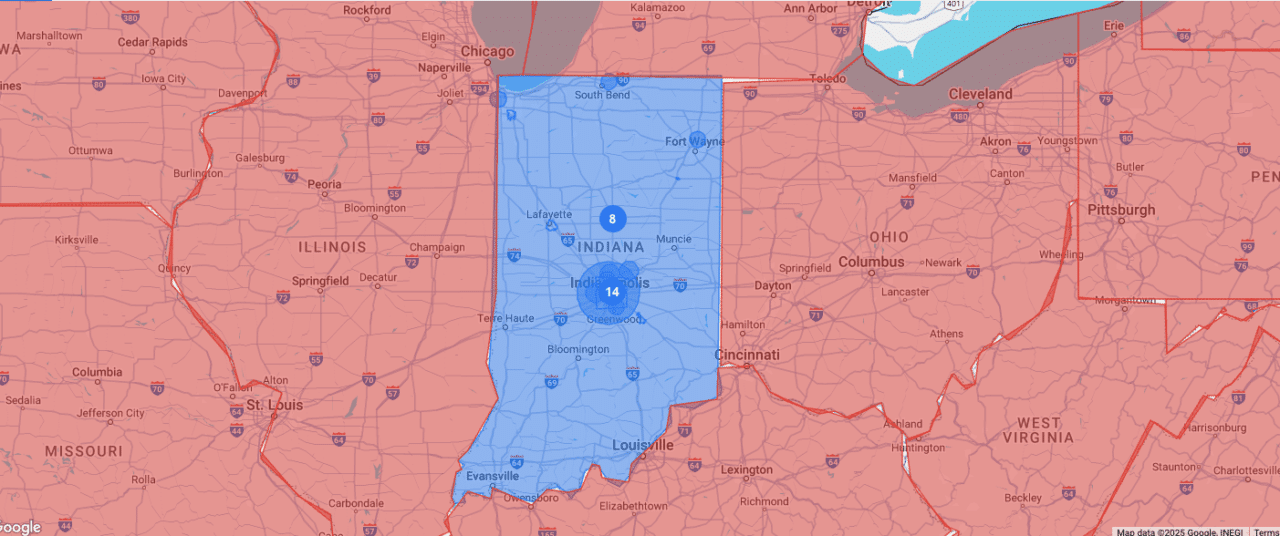
We didn’t target courthouses as potential leads would likely be expired by the statute of limitations once they reached the courthouse.
The results were quite impressive, based on the ROI figures in these reports:
| Locations | Conversions |
|---|---|

| 
|
How Do Businesses Run Geofencing Ad Campaigns?
There are several ways to use geofencing in an advertising campaign. You can use digital advertising platforms like Google Ads and Facebook Ads that provide geofencing capabilities, like targeted ads on specific locations. You can also use specialized geofencing software like Radar and Bluedot with advanced geofencing technology for finer accuracy using GPS, Wi-Fi, and device sensors.
If you’re already running Google ads, then you only need to change some settings in Locations when you’re creating ads.
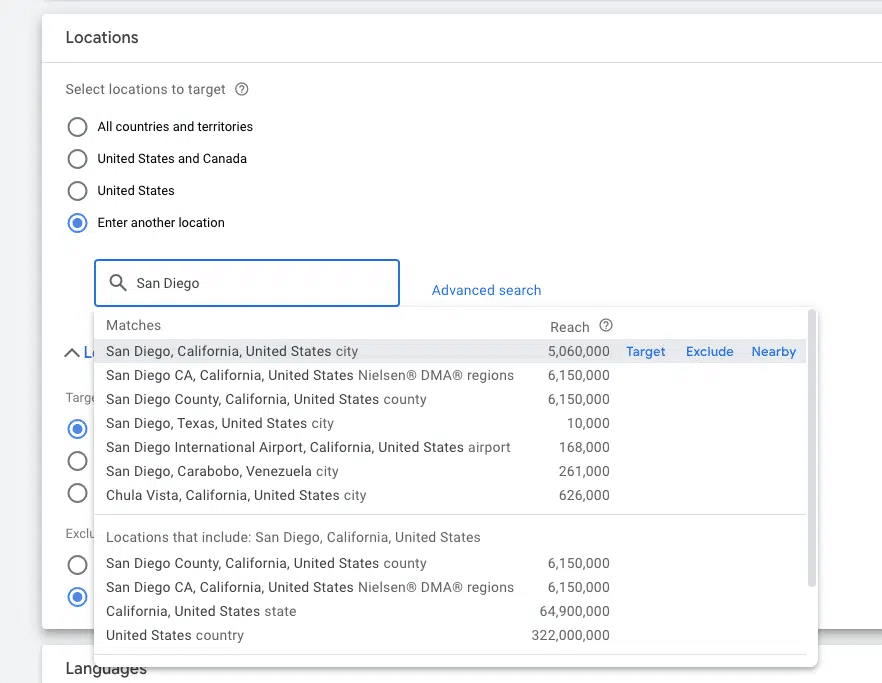
Let’s say you want to use a radius to define your geofence. Here’s what you should do next:
Before typing in a location, click Advanced search.

Click the radio button for Radius. Enter your target city and specify the radius you want (in miles). We recommend keeping geofences small to ensure high conversions.

When done, click Include and then the Save button at the bottom.
How To Use Geofencing To Attract More Customers
Running effective geofencing campaigns takes practice, but here are some of the best practices we’ve learned so far.
Define Your Geofences
Identify Your Target Audience’s Location/s and Keep It Small
As mentioned earlier, you’ll need to choose specific geographic areas where your ideal customers are likely to be. Focus on small, tightly defined zones such as a few blocks, neighborhoods, or a mile radius around key locations. This ensures your geofence targets only high-potential prospects.
Analyze Competitor Locations
Study where your competitors operate or attract traffic. Setting up geofences near their stores or service areas lets you intercept their foot traffic with timely promotions or ads—an effective way to win over potential customers.
Check Points of Interest (POIs) Relevant to Your Business
Look for places your customers frequently visit, like malls, local events, gyms, or universities. Geofencing around these POIs can help you reach users when they’re in a context relevant to your offering.
Optimize For Mobile
Geofencing marketing targets potential customers using their mobile phones and devices. This is why your strategy needs to be fundamentally designed for mobile.
This means you have to:
- Design ads, landing pages, and notifications specifically for mobile screens by creating concise copy, clear visuals, and fast-loading content.
- Encourage users to download and enable your app for better engagement, such as in-app rewards or personalized recommendations.
- Ensure that clicking a notification or ad leads to a mobile-optimized page or app experience, with easy navigation and minimal friction.
Doing this will give your geofencing campaigns the best user experience and can greatly improve conversions.
Use Multiple Targeting Techniques
Now that you know the basics of geofencing, let’s dive into these common targeting techniques marketers use to geofence.
- Context targeting – This is when you target customers based on where they are and what they are looking at online. This means ads appear to people who are in a certain area and who are interested in content related to the product or service being advertised, which makes the ads more relevant and engaging.
- Content targeting – Content targeting means changing the ads or messages that people get inside a specific area based on what they like or do. This makes sure that the ads match what people are interested in or need right now, which makes them more likely to buy. For example, a store might send a coffee deal to people nearby who have shown they like food and drinks.
- Retargeting/remarketing – Retargeting or remarketing lets you reach people who’ve already visited a specific location or interacted with your brand. Once they leave the area, you can show them personalized ads on other platforms for up to 30 days.
Note that this technique may not be allowed for industries with strict advertising rules (like law firms and health providers). For instance, we don’t use remarketing for personal injury law firm campaigns due to privacy policy violations. - Dayparting – Dayparting lets you schedule your geofencing ads to appear at the times when your audience is most likely to pay attention, like certain hours of the day or specific days of the week. For instance, a plumber might choose to run their ads after office hours or during the weekend when most people are at home and might need help with repairs.
Optimize Your Google My Business (GMB) and Local Listings
Optimizing your Google Business Profile (GBP) boosts your chances of showing up in Google’s Local Pack, which is the top local search results users see when they’re near your business, like this one for the search query “plumbers in Miami Florida.”
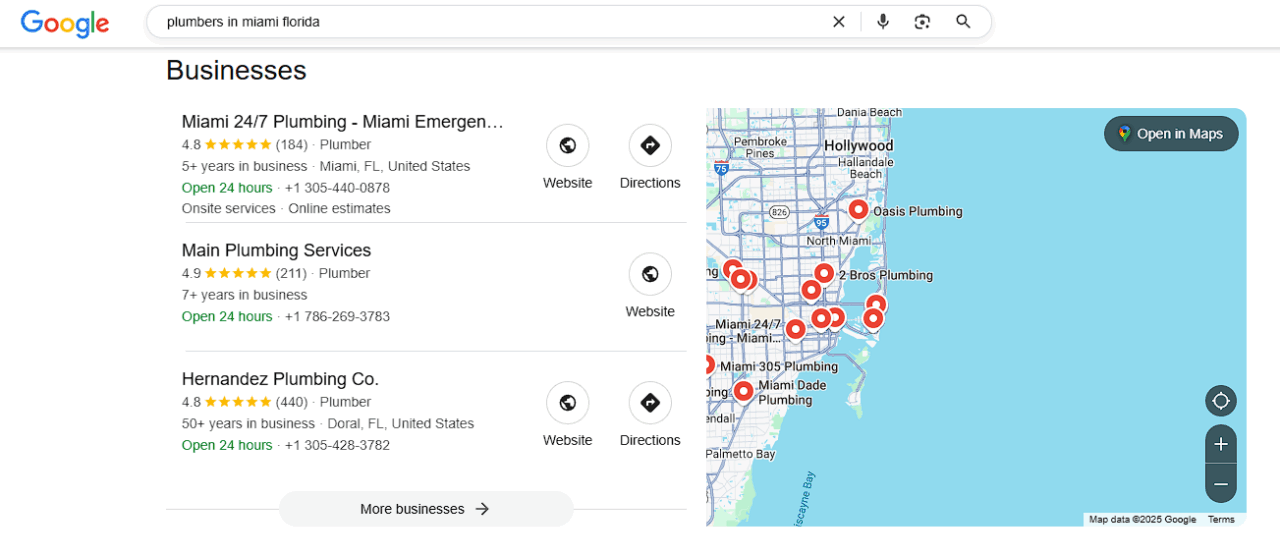
When you’re using location-based advertising, a strong local search presence helps make sure your business is visible when nearby customers are ready to take action.
Some tips on improving your GBP profile include:
- Keep your NAP (Name, Address, Phone) information consistent across all local directories.
- Check other business listings and make sure the NAP is consistent with your GBP
- Encourage local reviews and respond to them
- Upload professional photos of your business to your profile page
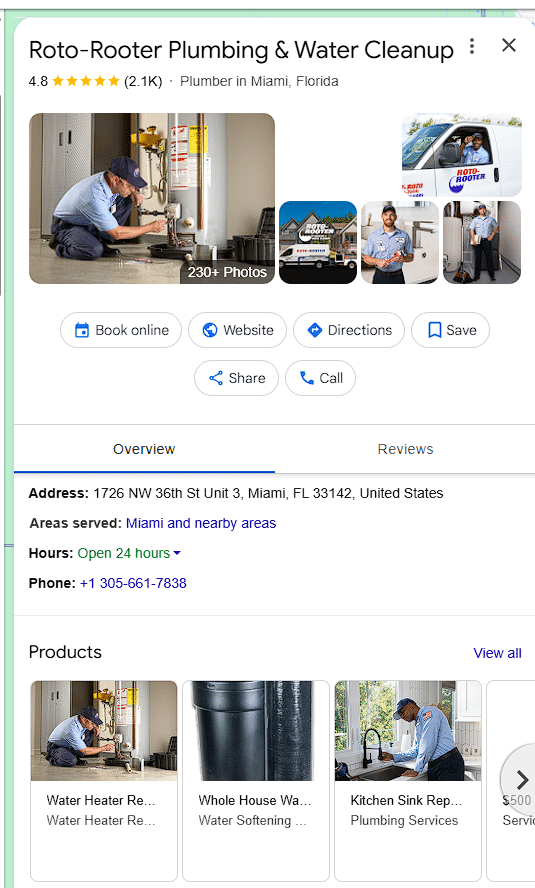
Local Keyword Research and Optimization
Identify highly relevant local keywords and phrases used by target audiences in specific areas and integrate these keywords naturally into ads, website content, meta descriptions, and headers.
When you optimize for local keywords, your business can improve in local search rankings. Geofencing builds on this by sending timely, location-based ads or alerts as soon as those users enter your geofenced area, encouraging them to visit your retail store or office.
Run Hyper-Local Ad Campaigns (PPC)
Geofencing can make pay-per-click (PPC) campaigns like Google ads more efficient and cost-effective by targeting people who visit specific locations with high intent.
- Focus on a specific area to target. Always have a reason why you’re targeting an area, whether it’s based on a radius, a competitor, or your target audience’s behaviors.
- Use demographics to inform your campaigns. In addition to specifying a location, using demographic information to target audiences can help with the success of a PPC ad. In our campaigns for contractors, we found that the average income level of neighborhoods can help us determine if they would be the right fit to afford services such as plumbers and roofers.
- Write clear ad copy with a compelling call-to-action (CTA). Ad copy and creative are all about clearly showing the exact service provided and supplementing it with trust factors, CTAs, and unique offers depending on your industry.
Below is an example of an ad copy for a personal injury firm.
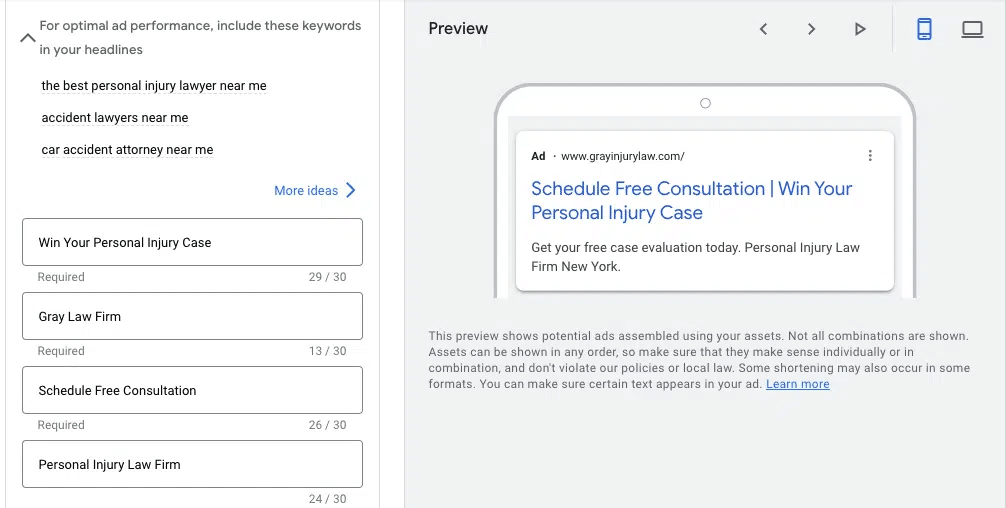
And here are example headlines we used for our roofer contractor clients:
Voted Best Roofers in XX
Same-day Free Estimate
Get a Free Roof Inspection
5-Star Rated Roofing Company
24/7 Emergency Services
Upgrade Your Home's Appeal
- Choose the correct bidding strategy
When you create ads, Google might ask you how you want to bid.

Automated bidding might sound promising, but this might not be the right choice if you’re targeting locations. Automated bidding strategies such as ‘maximize conversions/leads’ can override location bid adjustments.
This means that even if you set higher or lower bids for specific geographic areas, the automated system may ignore or minimize the impact of those settings in favor of its own optimization logic.
If you’re just starting to create an ad, you can switch to Manual bidding, but if it’s an existing ad (with positive results), you’ll need to segment the ad and change the bidding strategy to manual bidding.
- Control budget costs by separating campaigns
Based on the performance of geofencing in the same campaign with bid adjustments, separate campaigns may be needed to properly geofence, where we exclude certain locations from one campaign and control how much budget we allocate to them by separating them in a different campaign.
- Don’t include irrelevant areas
Narrow down zip codes, cities, counties, and DMA regions to increase overall campaign performance and avoid wasting your campaign budget on non-converting locations.
- Identify and negate non-converting geofences
If a geofence in your ads is generating leads but not converting within 3 to 9 months, it’s best to exclude these locations and reallocate the budget to high-converting leads instead. It’s better to place bid adjustments on areas that have produced more leads to favor more ad spend and competitive bidding on places that have generated more leads.
- Be mindful of privacy rules and limitations
Regulations like the California Consumer Privacy Act (CCPA) can limit ads to protect consumer data. Platforms like Google prohibit using sensitive personal information, such as health status, race, religion, or sexual orientation, for ad targeting.
Complying with these regulations and platform rules ensures that ads are ethical and consumers can opt out of ads.
However, this doesn’t mean that your campaigns won’t be effective.

All Google Ads campaigns focused on personal injury face the same privacy policy limits—so it’s an even playing field, not a disadvantage.

- Customer list data and geofencing are two separate things
The Reddit post below brings up some misconceptions about geofencing in the context of audience targeting.

This article has two items confused. Customer list data and geofencing are two separate things. When you upload a customer list or a list of device IDs, it needs to be well over 1k users. Even then, there is no guarantee that it will match as many as needed to make that audience of use. But this isn’t really relevant to the conversation around the proper implementation of geofencing.
- Allow a test period to gather solid data
Give geofencing at least a 15-day initial test period, then refine for the remainder of the 30 days, letting the data guide your optimizations. This duration is ample enough to find the best-converting geofences by watching how the target group reacts to the campaign in real life, allowing for changes based on data.
Analyze Local User Behavior and Trends
After running your geofencing campaigns for a few weeks or months, you’ll start to see valuable data about how your customers behave over time. This includes insights into foot traffic patterns, peak hours, and which services are most popular in specific locations. You can use this information to fine-tune your strategies and make better decisions.
Over time, we also begin to narrow down the top converting days and times of days where we are most likely to get conversions, optimizing the ad schedule but excluding high cost per conversion periods or non-converting times altogether.
Track Your GEO’s Performance With These KPIs
These are the key KPIs we focus on to measure the success of your geofencing campaigns:
- Conversions – The total number of desired actions users take after seeing or engaging with your ad.
- Conversion rate – The percentage of users who complete a desired action out of the total who interacted with your ad.
- Formula: (Conversions ÷ Clicks or Impressions) × 100
- Cost/conversion – The average amount you spend to get one conversion.
- Formula: Total Ad Spend ÷ Number of Conversions
- Cost per acquisition (CPA) – This measures how much it costs to acquire one paying customer or signed lead.
- Cost per click (CPC) – The average cost you pay for each click on your ad.
- Formula: Total Ad Spend ÷ Number of Clicks
First, we look at the number of conversions—mainly calls and form submissions—it has generated.
Then, we evaluate the conversion rate; ideally, it should be above 5–10%.
We also consider the cost per conversion, since geofencing often involves strong bid adjustments on specific locations, which can lead to higher CPCs.
By analyzing conversion rates, you can narrow down the top-converting days and times. This allows you to optimize your ad schedule by excluding high-cost or non-converting periods, maximizing your budget efficiency.
These KPIs should result in a signed case (for legal industries) or a new client (for trade industries).
Want Us to Launch a Geofencing Marketing Campaign For You?
Geofencing marketing can help you target the right customers at the right time—when they’re near your local business and ready to engage. Whether you’re a law firm, contractor, or local service provider, this strategy puts your brand in front of people in real time.
If you’re going the DIY route, here’s when to use each geofence type:
- Radial: Fast setup, good for broad coverage; less precise in irregular areas.
- Proximity: Ultra-local (Bluetooth/Wi-Fi), perfect for in-store triggers; more complex to deploy.
- Dynamic: Real-time adjustments (traffic, hours); highest relevance but requires robust data feeds.
But we can also handle every step of the campaign—from setting up precise location boundaries to tracking conversions. Contact us today and let our team create a high-performing geofencing campaign tailored to your business goals.
Table of Contents
Related Articles
Dominate Your Market with Digital Marketing Services That Deliver
Talk to a certified professional today, and we will design a strategy specific to your case.








